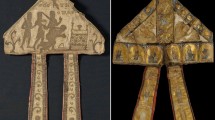Abstract
Portable instruments that can perform non-destructive analysis techniques are of great importance due to their high applicability, which can extend beyond the controlled laboratory environment. Their importance has long been recognised in the archaeometric field where art historians, conservators and restorers perform analyses on art works without causing any damage and without the need to move the objects to specialized laboratories. The X-ray fluorescence (XRF) technique is a popular choice in the archaeometric field for in situ investigations with portable instrumentations. This enables qualitative (elemental analysis) and quantitative (chemical composition) information retrieval from the objects of interest. Quantitative analyses can be performed under the assumption that the sample is homogeneous and its surface material is the same as in the rest of the object.
This work aims to expose various details, including the strengths and the weaknesses of typical XRF analyses in the case of surface alterations, focusing on portable implementations. The chosen approach will be in line with certain issues considered important in archaeometry; nevertheless the presented findings are valid beyond this. We will focus our discussion on two kinds of objects that can be found in the cultural heritage field: artefacts that had their surface material altered due to prolonged exposure to the environment and artefacts that have been gilded. Our work also includes a critically examined overview of relevant information available in the literature. The core of our analysis focuses on two main distinct cases, that of multilayer objects and that of bronzes.
Similar content being viewed by others
References
A. Longoni, C. Fiorini, P. Leutenegger, S. Sciuti, G. Fronterotta, L. Strüder, P. Lechner, Nucl. Instrum. Methods A 409, 407 (1998)
P. Moioli, C. Seccaroni, X-ray Spectrom. 29, 48 (2000)
C. Zarkadas, A.G. Karydas, Spectrochim. Acta B 59, 1611 (2004)
A. Gianoncelli, J. Castaing, A. Bouquillon, A. Polvorinos, P. Walter, X-ray Spectrom. 35, 365 (2006)
J. Tate, Nucl. Instrum. Methods B 14, 20 (1986)
A. Giumlia-Mair, Proc. 10th Int. Conf. on Particle Induced X-ray Emission and its Analytical Applications, Portorož, Slovenia, June 4–8, (2004)
R. Linke, M. Schreiner, G. Demortier, M. Alram, X-ray Spectrom. 32, 373 (2003)
R. Linke, M. Schreiner, G. Demortier, Nucl. Instrum. Methods B 226, 172 (2004)
C. Fiorini, A. Gianoncelli, A. Longoni, F. Zaraga, X-ray Spectrom. 31, 92 (2002)
R.M. Rousseau, X-ray Spectrom. 13, 115 (1984)
A. Longoni, A. Gianoncelli, C. Fiorini, Alta Frequenza 13, 22 (2001)
C. Fiorini, A. Gianoncelli, A. Longoni, Proceeding of the Workshop Nazionale “Microelettronica e beni culturali”, Firenze, 19 Marzo 2001 (2002), p. 74
QXAS-Axil software package available at http://www.iaea.org/OurWork/ST/NA/NAAL/pci/ins/xrf/pciXRFdown.php (2004)
G. Lombardi, Archaeometry 40, 601 (2002)
F. Beauchesne J.N. Barrandon, L. Alves, F.B. Gil, M.F. Guerra, Archaeometry 30, 187 (1988)
R. Klockenkämper, H. Bubert, K. Hasler, Archaeometry 41, 311 (1999)
L. Robbiola, J.-M. Blengino, C. Fiaud, Corros. Sci. 40, 2083 (1998)
H. Strandberg, Atmosph. Environ. 32, 3511 (1998)
F. Mathis, PhD Thesis, Université Paris XI, Orsay, 2005
T. Beldjoudi, F. Bardet, N. Lacoudre, S. Andrieu, A. Adriens, I. Costantinides, P. Brunella, La Revue de Métallurgie-CIT/Science et Génie des Matériaux (Septembre 2001), p. 804
www.eu-artech.org
L. Beck, S. Reveillon, S. Bosonnet, D. Eliot, F. Pilon, Nucl. Instrum. Methods B 226, 153 (2004)
N. Ammannati, E. Martellucci, C. Parisi Presicce, A.M. Carruba, Proc. 28th Convegno Nazionale AIM (Milano, Nov. 8–10, 2000)
Author information
Authors and Affiliations
Corresponding author
Additional information
PACS
78.66.Bz; 78.70.En; 33.20.Rm
Rights and permissions
About this article
Cite this article
Gianoncelli, A., Kourousias, G. Limitations of portable XRF implementations in evaluating depth information: an archaeometric perspective. Appl. Phys. A 89, 857–863 (2007). https://doi.org/10.1007/s00339-007-4221-4
Received:
Accepted:
Published:
Issue Date:
DOI: https://doi.org/10.1007/s00339-007-4221-4




